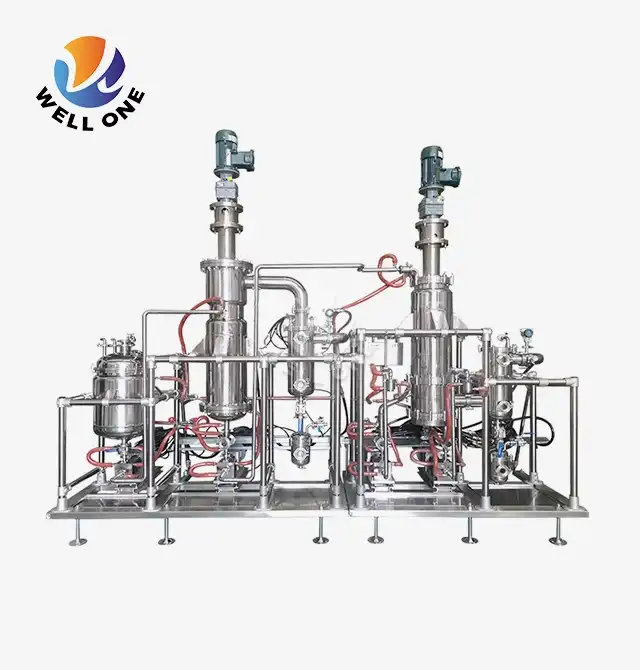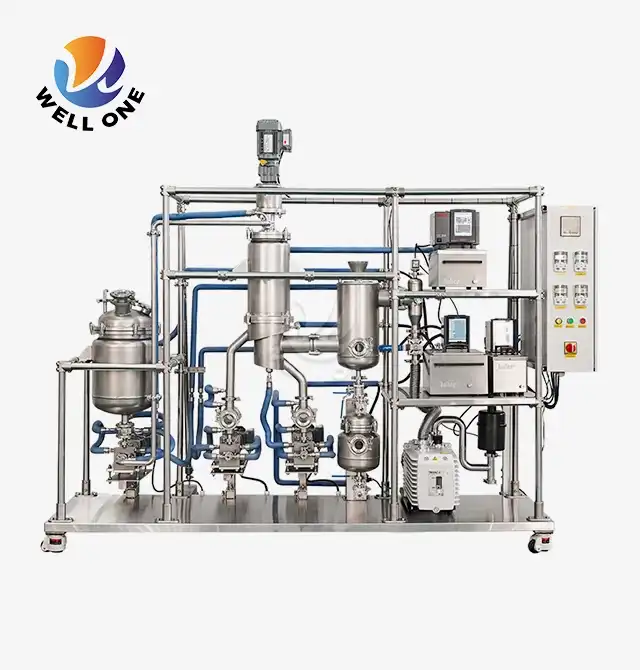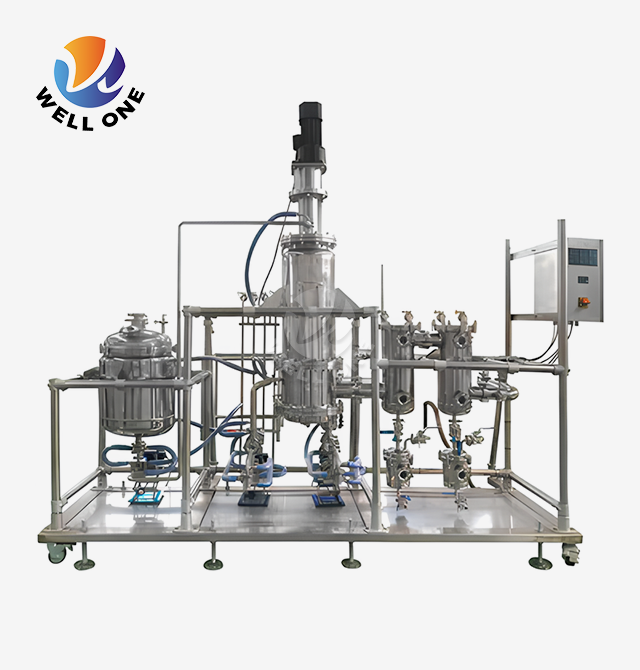What is the molecular distillation workflow?
When processing heat-sensitive compounds like pharmaceutical APIs, essential oils, or omega-3 fatty acids, traditional distillation methods often lead to thermal degradation and product loss. The molecular distillation workflow addresses this critical challenge by operating under extreme vacuum conditions with minimal thermal exposure. Laboratory Molecular Distillation systems enable researchers and manufacturers to achieve purities exceeding 98% while preserving delicate molecular structures that would otherwise decompose under conventional distillation temperatures.
Understanding Laboratory Molecular Distillation Technology
Laboratory Molecular Distillation represents a specialized separation technique that operates on fundamentally different principles than conventional distillation methods. Unlike traditional processes that rely on vapor-liquid equilibrium, this advanced technology exploits the molecular mean free path concept to achieve separation at temperatures far below normal boiling points. The workflow involves creating an ultra-high vacuum environment where individual molecules can evaporate, travel a short distance without collision, and condense independently on a nearby cold surface. The technology distinguishes itself through three critical operational parameters that define the molecular distillation workflow. First, the vacuum level must reach pressures below 0.01 torr to ensure molecules travel freely without intermolecular collisions. Second, the distance between the evaporating surface and condenser must remain within the molecular mean free path range, typically 2-5 centimeters. Third, the residence time of material on the heated surface must be minimized to seconds or milliseconds to prevent thermal decomposition of sensitive compounds.
Core Components of Laboratory Molecular Distillation Systems
The molecular distillation workflow relies on precisely engineered equipment components that work synergistically to achieve optimal separation efficiency. The evaporator section features a heated cylindrical surface constructed from 316 stainless steel, providing exceptional corrosion resistance and thermal stability. Material is distributed across this surface as a thin film, typically 0.05-0.1 millimeters thick, through mechanical wipers or centrifugal force depending on the system design. This ultra-thin film maximizes the surface area-to-volume ratio, facilitating rapid evaporation while minimizing thermal exposure. The condenser assembly surrounds the evaporator at a precisely controlled distance, maintaining temperatures significantly below the evaporation zone to ensure immediate condensation of vapor molecules. Advanced Laboratory Molecular Distillation systems incorporate separate collection vessels for distillate and residue fractions, enabling continuous operation and precise fraction separation. Modern units feature ABB control systems that monitor and adjust temperature, pressure, vacuum level, feed rate, and wiper speed with accuracy within ±0.1%, ensuring reproducible results across batches and enabling seamless scale-up from research to production.
Critical Process Parameters in Molecular Distillation Workflow
Temperature control represents the most crucial parameter in the molecular distillation workflow, requiring precise management across multiple zones. The evaporator temperature typically ranges from 50°C to 300°C depending on the compound being processed, with heat-sensitive materials like CBD isolates or vitamin E processed at the lower end of this range. The condenser temperature must maintain a sufficient temperature differential to ensure complete condensation while preventing thermal shock to the distillate. Advanced systems employ multi-stage heating with independent temperature zones, allowing operators to optimize thermal profiles for specific applications. Vacuum pressure directly determines the mean free path of molecules and consequently affects separation efficiency in Laboratory Molecular Distillation operations. Ultra-high vacuum levels below 0.001 millibar minimize intermolecular collisions and reduce the required evaporation temperature, protecting thermally labile compounds from degradation. Feed flow rate must be carefully balanced against evaporator surface area and heating capacity to maintain optimal film thickness and residence time. Excessive feed rates result in incomplete evaporation and reduced purity, while insufficient feed rates decrease throughput and economic efficiency.
The Step-by-Step Molecular Distillation Workflow Process
The molecular distillation workflow begins with comprehensive feed material preparation to ensure optimal processing conditions and maximum yield. Raw materials undergo degassing to remove dissolved gases that could interfere with vacuum stability and cause foaming during evaporation. Pre-heating the feed material to approximately 60-80°C reduces viscosity, facilitating uniform film formation on the evaporator surface and preventing mechanical stress on the wiper system. For materials containing particulates or suspended solids, filtration through 10-50 micron filters prevents equipment fouling and ensures consistent operation throughout extended production runs.
Material Introduction and Film Formation
Feed material enters the Laboratory Molecular Distillation system through a precisely controlled metering pump that maintains constant flow rate regardless of pressure fluctuations or viscosity changes. The material is distributed onto the heated evaporator surface through a specialized feed distributor designed to ensure uniform coverage across the entire evaporation zone. In falling film configurations, gravity and mechanical wipers spread the liquid into a thin, uniform layer as it flows downward. Centrifugal systems employ high-speed rotation, typically 300-1500 RPM, to create centrifugal force that spreads material across the inner wall of a rotating cylinder, forming a stable thin film. The mechanical wiper system plays a critical role in maintaining optimal film characteristics throughout the molecular distillation workflow. Wipers continuously renew the evaporating surface by distributing fresh material and preventing the formation of dry spots or areas of excessive thickness. In wiped film molecular distillers, PTFE or similar low-friction materials are used for wiper blades, ensuring gentle material handling while minimizing mechanical degradation. The wiper speed is adjustable from 50 to 500 RPM, allowing optimization for materials with different viscosities and thermal sensitivities.
Evaporation and Molecular Separation
Under the combined influence of heat and vacuum, volatile components begin evaporating from the thin film surface in the Laboratory Molecular Distillation unit. Individual molecules escape the liquid phase and enter the vapor space where they travel in straight lines toward the condenser surface. Because the pressure is maintained below the mean free path threshold, these molecules traverse the short distance without colliding with other molecules, maintaining their individual identities and kinetic energies. This collision-free travel is the defining characteristic of true molecular distillation and distinguishes it from short-path distillation or other vacuum distillation techniques. The separation mechanism in molecular distillation workflow exploits differences in vapor pressure and molecular weight rather than relying on vapor-liquid equilibrium. Lighter, more volatile molecules evaporate preferentially and reach the condenser first, while heavier, less volatile components remain in the liquid film on the evaporator surface. This continuous preferential evaporation creates a concentration gradient within the thin film, with the surface layer becoming enriched in heavy components as light components are progressively removed. The efficiency of this separation depends on maintaining optimal film thickness, temperature differential, and vacuum level throughout the process.
Condensation and Product Collection
Molecules reaching the condenser surface immediately release their latent heat and return to liquid phase, forming droplets that flow downward under gravity into dedicated collection vessels. The molecular distillation workflow typically produces two primary fractions: the distillate containing lighter, more volatile components, and the residue containing heavier, less volatile materials. Advanced Laboratory Molecular Distillation systems feature multiple collection points enabling intermediate fraction capture, particularly valuable when processing complex mixtures requiring precise fractionation. The condenser surface temperature is maintained significantly below the evaporator temperature, typically 20-100°C lower depending on the application. Cooling is accomplished through circulating heat transfer fluids or direct refrigeration, with temperature control accuracy within ±1°C ensuring consistent condensation efficiency. In multi-stage molecular distillation workflows, the distillate from one stage becomes the feed for subsequent stages, enabling increasingly refined separations and purities exceeding 99% for many applications. This cascading approach is particularly effective for concentrating EPA and DHA from fish oil, where four-stage systems can achieve 80% combined purity from crude feedstocks.
Advanced Laboratory Molecular Distillation Configuration Options
Single-stage Laboratory Molecular Distillation systems provide cost-effective solutions for applications requiring moderate purification or when processing materials with clear separation between target components and impurities. These configurations feature one evaporator-condenser pair and deliver distillate and residue as two discrete fractions. Single-stage units excel in deacidification applications such as tea oil refining, solvent recovery from botanical extracts, and removal of light contaminants from heavy base materials. With evaporation surfaces ranging from 0.1 to 2 square meters, these systems accommodate laboratory research through pilot-scale production with throughputs from 1 to 50 liters per hour.
Multi-Stage Molecular Distillation Workflows
Dual-stage and three-stage Laboratory Molecular Distillation configurations enable complex separations impossible with single-stage processing. In dual-stage workflows, the first stage removes light impurities and volatile contaminants while the second stage separates the target fraction from heavy residues. This two-step purification is ideal for squalene extraction, where the first stage eliminates fatty acids and light esters, and the second stage concentrates squalene to 98% purity. Three-stage systems add an additional purification step, enabling recovery of intermediate fractions and achieving pharmaceutical-grade purity for APIs and nutraceutical compounds. The molecular distillation workflow in multi-stage configurations requires careful optimization of interstage conditions to maximize overall yield and purity. Each stage operates at progressively higher temperatures and lower pressures, with intermediate storage vessels or direct cascading between stages. Material balance calculations and thermal analysis determine optimal feed rates and temperature profiles for each stage, considering the changing composition and physical properties as lighter fractions are progressively removed. Advanced ABB control systems integrate all stages, enabling automated sequential processing with real-time parameter adjustment based on measured distillate properties and flow rates.
Continuous vs. Batch Molecular Distillation Operations
Batch Laboratory Molecular Distillation workflows involve processing discrete quantities of feed material with complete startup and shutdown cycles for each batch. This approach offers flexibility for processing multiple products on the same equipment, simplified cleaning validation between campaigns, and easier quality control through discrete batch identity. Batch processing is preferred for high-value, low-volume applications such as pharmaceutical API purification, where each batch may represent a different compound or formulation requiring unique processing parameters. Typical batch sizes range from 5 to 500 liters depending on evaporator surface area and material characteristics. Continuous molecular distillation workflows maintain steady-state operation with continuous feed input and product discharge, maximizing equipment utilization and production capacity. This mode is advantageous for large-volume applications such as fish oil refining, lubricating oil regeneration, and essential oil concentration where consistent product specifications and high throughput are essential. Continuous Laboratory Molecular Distillation systems incorporate level controls, automatic feed rate adjustment, and continuous vacuum maintenance to ensure stable operation over extended periods. Modern units can operate continuously for weeks between maintenance shutdowns, processing thousands of liters with consistent quality and minimal operator intervention.
Industry-Specific Molecular Distillation Workflow Applications
In pharmaceutical manufacturing, the molecular distillation workflow ensures GMP-compliant purification of active pharmaceutical ingredients while maintaining bioactivity and chemical structure. Laboratory Molecular Distillation systems with CIP and SIP capabilities meet stringent regulatory requirements for equipment sanitization and product purity. Applications include concentration of polyethylene glycol to achieve narrow molecular weight distributions below 1.05 dispersity index, purification of lipid nanoparticles for drug delivery systems, and removal of residual solvents to meet ICH guidelines. The gentle processing conditions preserve chirality and prevent racemization of optically active compounds, critical for maintaining pharmaceutical efficacy.
Food and Nutraceutical Processing Workflows
The food industry leverages molecular distillation workflow technology to concentrate omega-3 fatty acids from marine sources while preserving nutritional value and preventing oxidation. Fish oil undergoes preliminary esterification and dehydration before entering four-stage Laboratory Molecular Distillation systems that progressively concentrate EPA and DHA from initial levels around 30% to final purities exceeding 80%. This multi-stage approach achieves recovery rates of 70% compared to only 16% with traditional methods, while producing products with superior color, minimal fishy odor, and low peroxide values indicating excellent oxidative stability. Tea oil deacidification represents another critical application where molecular distillation workflow replaces problematic alkaline refining methods. Traditional deacidification damages beneficial tocopherols and phytosterols while generating substantial wastewater requiring treatment. Laboratory Molecular Distillation operating at 150-180°C under 0.1 Pa vacuum selectively removes free fatty acids while retaining valuable nutritional components. The process reduces acidity from 5-10% down to below 0.5% without generating waste streams, producing premium-quality tea oil suitable for nutritional supplement applications and commanding significant price premiums.
Essential Oil and Natural Product Purification
Rose essential oil purification exemplifies the molecular distillation workflow's capability to handle extremely valuable, heat-sensitive natural products. Rose crude oil obtained through supercritical CO2 extraction contains numerous impurities, waxes, and off-odor compounds that diminish quality and market value. Laboratory Molecular Distillation operating at 80-120°C under ultra-high vacuum selectively removes these contaminants while preserving the delicate aromatic profile that commands premium pricing. The process eliminates traditional dewaxing methods that risk molecular rearrangement, oxidation, and solvent residues, producing rose essential oil with authentic fragrance profiles meeting the demanding specifications of luxury perfume houses. Botanical extract purification for cosmetic applications employs molecular distillation workflows to concentrate bioactive compounds while removing solvents and unwanted components. Extracts from plants used in skincare formulations contain valuable antioxidants, vitamins, and phytochemicals requiring gentle processing to maintain efficacy. Laboratory Molecular Distillation with falling film evaporators removes extraction solvents like hexane, methanol, or ethanol to residual levels below 10 ppm, meeting cosmetic safety standards. The purified extracts exhibit enhanced stability, improved sensory properties, and higher concentrations of active ingredients, enabling formulators to create more effective products with lower usage rates.
Technical Specifications and Quality Assurance in Laboratory Molecular Distillation
Modern Laboratory Molecular Distillation systems incorporate advanced materials and precision engineering to ensure reliable performance across demanding applications. Evaporator and condenser surfaces are constructed from 316L stainless steel providing exceptional corrosion resistance against aggressive chemicals, organic acids, and oxidizing compounds. All product-contact surfaces achieve Ra 0.8 surface finishes through electropolishing, eliminating microscopic irregularities that could harbor contaminants or cause product holdup. Mechanical seals employ PTFE or graphite compounds compatible with high temperatures and chemical exposure, maintaining vacuum integrity over thousands of operating hours.
Vacuum System Design and Performance
The vacuum system represents a critical component in the molecular distillation workflow, requiring specialized design to achieve and maintain ultra-high vacuum levels. Two-stage or three-stage rotary vane pumps provide backing vacuum down to 0.1 Pa, while diffusion pumps or turbomolecular pumps reach ultimate pressures below 0.001 Pa in the distillation chamber. Cold traps positioned between the distillation unit and vacuum pumps condense vapors that would otherwise contaminate pump oil or damage pump components, extending maintenance intervals and ensuring consistent vacuum performance. Digital vacuum gauges with 0.001 Pa resolution monitor pressure throughout the system, providing real-time feedback to control systems that automatically adjust pump speed and valve positions. Leak detection and prevention are essential for maintaining optimal molecular distillation workflow performance. Even microscopic leaks can significantly degrade vacuum levels and separation efficiency, particularly when processing low-vapor-pressure compounds requiring ultimate vacuum conditions. Modern Laboratory Molecular Distillation systems incorporate helium leak detection ports at critical sealing points, enabling routine verification of system integrity. All flanged connections employ metal gaskets or specialized elastomer seals with documented compatibility with process chemicals and operating temperatures, ensuring long-term reliability without performance degradation.
Automated Process Control and Data Logging
Advanced Laboratory Molecular Distillation units feature comprehensive automation through ABB programmable logic controllers interfacing with precision sensors and actuators throughout the system. Temperature control employs PID algorithms with auto-tuning capabilities, maintaining setpoints within ±0.5°C across wide load variations. Feed rate control uses mass flow meters and variable-speed pumps to deliver material at programmed rates with ±1% accuracy, ensuring consistent film thickness and residence time. Vacuum control systems continuously monitor pressure at multiple locations, automatically adjusting pump speeds and vent valves to compensate for process variations and maintain optimal separation conditions. Data logging and recipe management capabilities enable operators to develop, store, and recall processing protocols for different products and applications. All critical process parameters including temperatures, pressures, flow rates, and equipment speeds are recorded at one-second intervals throughout production runs, creating comprehensive batch records for quality assurance and regulatory compliance. Trend analysis tools identify process variations and performance drift before they impact product quality, supporting predictive maintenance and continuous improvement initiatives. Remote monitoring capabilities allow supervisors to oversee multiple Laboratory Molecular Distillation installations from centralized control rooms, optimizing resource utilization and enabling rapid response to process upsets.
Optimizing Molecular Distillation Workflow for Maximum Efficiency
Feed material characteristics significantly influence molecular distillation workflow performance and require careful evaluation during process development. Viscosity affects film formation and thickness, with highly viscous materials requiring higher temperatures or dilution to achieve optimal spreading on the evaporator surface. Materials containing suspended solids or polymerizable compounds may foul the evaporator or wiper system, necessitating pre-filtration or periodic cleaning cycles. Thermal stability testing determines the maximum safe processing temperature where decomposition or degradation remains below acceptable thresholds, defining the upper limit for evaporator temperature settings.
Process Development and Scale-Up Methodology
Laboratory-scale experiments using bench-top Laboratory Molecular Distillation units with 0.1-0.5 square meter evaporation surfaces establish baseline separation performance and identify optimal operating parameters. These trials systematically vary temperature, pressure, feed rate, and wiper speed while measuring distillate yield, purity, and residue composition to develop empirical relationships between process conditions and performance. Statistical design of experiments approaches efficiently explore the parameter space, identifying main effects and interactions that guide parameter optimization. Successful laboratory trials generate processing protocols ready for pilot-scale validation. Pilot-scale molecular distillation workflow trials using 1-2 square meter evaporation surfaces verify laboratory findings at increased throughput and identify scale-dependent effects not apparent in small-scale studies. Longer continuous run durations reveal potential fouling issues, equipment wear patterns, and process stability characteristics requiring attention during commercial operation. Material balance closure and energy consumption data from pilot runs enable accurate economic projections and inform final equipment sizing decisions. Successful pilot campaigns demonstrate technical feasibility and provide samples for market evaluation, reducing risk before committing to full-scale production investments.
Troubleshooting Common Workflow Challenges
Incomplete separation in Laboratory Molecular Distillation workflows often results from insufficient vacuum levels, excessive feed rates, or inadequate temperature differentials between evaporator and condenser. Systematic diagnosis begins with verifying actual operating conditions against setpoints, identifying control system failures or sensor drift. If conditions are within specifications, the issue may involve feed material property changes requiring parameter adjustment. Reducing feed rate increases residence time and allows more complete evaporation, while increasing evaporator temperature or improving vacuum levels enhances the driving force for separation. Product discoloration or off-odors indicate thermal degradation occurring during the molecular distillation workflow, requiring immediate corrective action to prevent continued quality losses. Causes include excessive evaporator temperatures, prolonged residence times due to equipment fouling, or oxidation from air ingress into the vacuum system. Solutions involve reducing operating temperature, increasing feed rate to decrease residence time, verifying vacuum system integrity, and implementing nitrogen blanketing to create an inert atmosphere. For particularly sensitive materials, adding antioxidants or stabilizers to the feed may provide additional protection against degradation during processing.
Maintenance and Cleaning Protocols for Laboratory Molecular Distillation Systems
Routine maintenance schedules ensure reliable Laboratory Molecular Distillation operation and prevent unexpected downtime. Weekly inspections verify wiper blade condition, checking for wear or damage that could compromise film formation or scratch the evaporator surface. Vacuum system maintenance includes checking pump oil levels and quality, cleaning cold traps, and verifying leak-tight connections at all joints and seals. Quarterly maintenance involves more thorough inspections including bearing lubrication, motor brush examination, and calibration verification of all temperature sensors and pressure gauges against certified standards.
Cleaning Validation and Changeover Procedures
Cleaning protocols for Laboratory Molecular Distillation equipment depend on the products processed and subsequent contamination tolerance limits. Pharmaceutical applications require validated cleaning procedures demonstrating residue removal below established acceptance criteria, typically 10 ppm or less. Cleaning validation studies identify worst-case product combinations and establish effective cleaning agent concentrations, temperatures, and contact times. Analytical testing of rinse samples or direct surface swabs verifies cleaning effectiveness before authorizing equipment release for subsequent campaigns. Multi-product facilities implement efficient changeover procedures minimizing downtime between different molecular distillation workflows while ensuring product quality and preventing cross-contamination. Fast-rinse techniques using compatible solvents remove bulk residues before detailed cleaning, reducing overall cycle times. Modular design elements like quick-disconnect fittings and removable wiper assemblies facilitate access for thorough cleaning and inspection. Dedicated product-contact components for high-value or difficult-to-clean materials eliminate changeover requirements, simplifying operations and improving facility flexibility.
Certification, Compliance, and Quality Standards
Laboratory Molecular Distillation systems must meet rigorous international standards ensuring safety, performance, and regulatory compliance across diverse applications. CE marking certifies conformity with European Union directives covering equipment safety, electromagnetic compatibility, and pressure vessel regulations. ISO 9001 certification of manufacturing processes demonstrates consistent quality management throughout design, production, and service delivery. ATEX certification verifies explosion-proof designs for processing flammable materials in potentially hazardous environments, critical for petrochemical and solvent recovery applications.
Pharmaceutical and Food Safety Certifications
GMP-compliant Laboratory Molecular Distillation systems incorporate design features ensuring product purity, operator safety, and documentation integrity for pharmaceutical manufacturing. All product-contact surfaces are polished to pharmaceutical-grade finishes with documented material certifications and full traceability. Equipment qualification protocols including IQ/OQ/PQ documentation verify proper installation, operational performance, and process validation according to FDA and EMA guidelines. Data integrity features comply with 21 CFR Part 11 requirements for electronic records and signatures, protecting against unauthorized data modification and ensuring audit trail completeness. Food-grade Laboratory Molecular Distillation installations meet NSF/ANSI standards for materials and construction, preventing contamination and ensuring suitability for processing edible products. Stainless steel grades, gasket materials, and lubricants receive NSF certification for food contact applications. Allergen-free designs eliminate dead spaces and provide complete cleanability, preventing cross-contamination in facilities processing multiple ingredients. Kosher and Halal certifications may be required for certain markets, necessitating additional equipment modifications and dedicated processing arrangements.
Conclusion
The molecular distillation workflow represents the gold standard for purifying heat-sensitive compounds across pharmaceutical, food, and specialty chemical industries. Laboratory Molecular Distillation systems operating under ultra-high vacuum with minimal thermal exposure achieve purities exceeding 98% while preserving delicate molecular structures. Success depends on precise control of temperature, pressure, and feed conditions throughout multi-stage processing sequences tailored to specific applications and product requirements.
Cooperate with Xi'an Well One Chemical Technology Co., Ltd
Since 2006, Xi'an Well One Chemical Technology Co., Ltd., backed by Xi'an NewSet Chemical Equipment Technology Co., Ltd., has specialized in synthesis and purification separation equipment manufacturing. With a 1,500 m² office, 500 m² R&D laboratory, and 4,500 m² factory, the company offers comprehensive services including process development, equipment design, testing, and pilot services. The expert team delivers molecular distillation devices from laboratory to industrial scale, ensuring production capacity and quality across pharmaceutical, food, new materials, petrochemical, essence, and fine chemicals industries.
Our China Laboratory Molecular Distillation factory produces High Quality Laboratory Molecular Distillation systems with CE, ISO, UL, and SGS certification. As a leading China Laboratory Molecular Distillation supplier and China Laboratory Molecular Distillation manufacturer, we offer single-stage, dual-stage, and three-stage configurations with high vacuum degrees reaching 0.1 Pa. Our China Laboratory Molecular Distillation wholesale programs include ABB control systems and 316 stainless steel construction ensuring corrosion resistance and long-term reliability. With competitive Laboratory Molecular Distillation price points and comprehensive OEM & ODM support, we provide one-year warranty coverage. Contact our team to discuss your Laboratory Molecular Distillation for sale requirements and receive customized solutions for your specific application. Reach us at info@welloneupe.com to transform your separation challenges into purification success.
References
1. Batistella, C.B. and Wolf Maciel, M.R. "Molecular Distillation: Rigorous Modeling and Simulation for Recovery of Valuable Compounds from Complex Mixtures." Brazilian Journal of Chemical Engineering.
2. Lutisan, J. and Cvengros, J. "Mean Free Path of Molecules on Molecular Distillation." Chemical Engineering Journal.
3. Martini, S. and Anklam, E. "Molecular Distillation for the Separation of Tocopherols: Optimization and Modeling." Journal of the American Oil Chemists' Society.
4. Tovar, L.E.R., Fernández, P.R., and Gómez Castro, F.I. "Molecular Distillation: A Powerful Tool for Sustainable Processing of Complex Mixtures." Chemical Engineering and Processing: Process Intensification.







